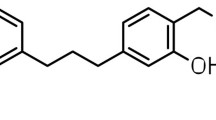Abstract
The use of mefloquine (MQ) for antimalarial treatment and prophylaxis has diminished largely in response to concerns about its neurologic side effects. An analog campaign designed to maintain the efficacy of MQ while minimizing blood–brain barrier (BBB) penetration has resulted in the synthesis of a prodrug with comparable-to-superior in vivo efficacy versus mefloquine in a P. berghei mouse model while exhibiting a sixfold reduction in CNS drug levels. The prodrug, WR319670, performed poorly compared to MQ in in vitro efficacy assays, but had promising in vitro permeability in an MDCK–MDR1 cell line BBB permeability screen. Its metabolite, WR308245, exhibited high predicted BBB penetration with excellent in vitro efficacy. Both WR319670 and WR308245 cured 5/5 animals in separate in vivo efficacy studies. The in vivo efficacy of WR319670 was thought to be due to the formation of a more active metabolite, specifically WR308245. This was supported by pharmacokinetics studies in non-infected mice, which showed that both IV and oral administration of WR319670 produced essentially identical levels of WR319670 and WR308245 in both plasma and brain samples at all time points. In these studies, the levels of WR308245 in the brain were 1/4 and 1/6 that of MQ in similar IV and oral studies, respectively. These data show that the use of WR319670 as an antimalarial prodrug was able to maintain efficacy in in vivo efficacy screens, while significantly lowering overall penetration of drug and metabolites across the BBB.





Similar content being viewed by others
References
Arguin PM, Mali S (2012) Malaria. CDC Yellow Book. http://wwwnc.cdc.gov/travel/yellowbook/2012/chapter-3-infectious-diseases-related-to-travel/malaria.htm. Accessed 12 Dec 2012
Caridha D, Yourick D, Cabezas M, Wolf L, Hudson TH, Dow GS (2008) Mefloquine-induced disruption of calcium homeostasis in mammalian cells is similar to that induced by ionomycin. Antimicrob Agents Chemother 52:684–693
Chulay JD, Haynes JD, Diggs CL (1983) Plasmodium falciparum—assessment of in vitro growth by [H-3]-labeled hypoxanthine incorporation. Exp Parasitol 55:138–146
Chung MC, Ferreira EI et al (2008) Prodrugs for the treatment of neglected diseases. Molecules 13:616–677
Desjardins RE, Canfield CJ, Haynes JD, Chulay JD (1979) Quantitative assessment of antimalarial activity in vitro by a semiautomated microdilution technique. Antimicrob Agents Chemother 16:710–718
Dow GS, Heady TN et al (2006) Utility of alkylaminoquinolinyl methanols as new antimalarial drugs. Antimicrob Agents Chemother 50:4132–4143
Dow GS, Magill AJ, Ohrt C (2008) Clinical development of new prophylactic antimalarial drugs after the 5th Amendment to the Declaration of Helsinki. Ther Clin Risk Manag 4:803–819
Johnson JD, Dennull RA, Gerena L, Lopez-Sanchez M, Roncal NE, Waters NC (2007) Assessment and continued validation of the malaria SYBR green I-based fluorescence assay for use in malaria drug screening. Antimicrob Agents Chemother 51:1926–1933
Milhous WK, Weatherly NF, Bowdre JH, Desjardins RE (1985) In vitro activities of and mechanisms of resistance to antifol antimalarial drugs. Antimicrob Agents Chemother 27:525–530
Milner E, McCalmont W et al (2010a) Structure-activity relationships amongst 4-position quinoline methanol antimalarials that inhibit the growth of drug sensitive and resistant strains of Plasmodium falciparum. Bioorg Med Chem Lett 20:1347–1351
Milner E, McCalmont W et al (2010b) Anti-malarial activity of a non-piperidine library of next-generation quinoline methanols. Malar J 9:51–60
Smilkstein M, Sriwilaijaroen N, Kelly JX, Wilairat P, Riscoe M (2004) Simple and inexpensive fluorescence-based technique for high-throughput antimalarial drug screening. Antimicrob Agents Chemother 48:1803–1806
Toovey S (2009) Mefloquine neurotoxicity: a literature review. Travel Med Infect Dis 7:2–6
Yelmo S, Morera-Fumero AL, Henry M, Renshaw A, Gracia-Marco R (2010) Mania Associated With Mefloquine Prophylaxis. J Clin Psychopharmacol 30:339–341
Author information
Authors and Affiliations
Corresponding author
Additional information
This manuscript was reviewed by the Walter Reed Army Institute of Research and the US Army Medical Research and Materiel Command, and there is no objection to its publication or dissemination. The opinions expressed herein are those of the authors and do not necessarily reflect the views or opinions of the Department of the Army and the Department of Defense. All animal experiments were conducted in compliance with the Animal Welfare Act and other federal statutes and regulations relating to animals and experiments involving animals and adhere to the principles stated in the Guide for the Care and Use of Laboratory Animals (National Academy Press, 1996).
Rights and permissions
About this article
Cite this article
Sousa, J.C., Milner, E., Carroll, D. et al. The use of a prodrug approach to minimize potential CNS exposure of next generation quinoline methanols while maintaining efficacy in in vivo animal models. Eur J Drug Metab Pharmacokinet 39, 231–236 (2014). https://doi.org/10.1007/s13318-013-0162-9
Received:
Accepted:
Published:
Issue Date:
DOI: https://doi.org/10.1007/s13318-013-0162-9




